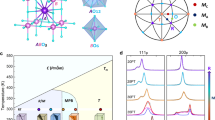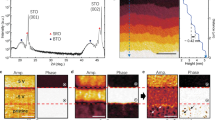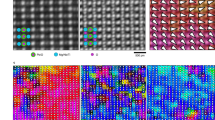Abstract
Relaxor ferroelectrics, with their strong dependence of polarization on the applied electric field, are of considerable technological importance. On a microscopic scale, however, there exists competition as well as coexistence between short-range and long-range polar order. The conventional picture is that the polar nano-regions (PNRs) that appear at high temperatures beyond the Curie transition, form nuclei for the field-induced long-range order at low temperatures. Here, we report high-energy X-ray diffuse-scattering measurements on the relaxor Pb(Zn1/3Nb2/3)O3 (PZN) to study the short-range polar order under an electric field applied along the [111] direction. In contrast to conventional expectations, the overall diffuse-scattering intensity is not suppressed. On the other hand, the field induces a marked change on the shape of the three-dimensional diffuse-scattering intensity pattern, corresponding to a redistribution of PNRs in real space. We show that these surprising results are consistent with a model in which the PNRs with [110]-type polarizations, orthogonal to that of the surrounding environment, are embedded and persist in the [111]-polarized ferroelectric order of the bulk.
This is a preview of subscription content, access via your institution
Access options
Subscribe to this journal
Receive 12 print issues and online access
$259.00 per year
only $21.58 per issue
Buy this article
- Purchase on Springer Link
- Instant access to full article PDF
Prices may be subject to local taxes which are calculated during checkout






Similar content being viewed by others
References
Park, S.-E. & Shrout, T. R. Ultrahigh strain and piezoelectric behavior in relaxor based ferroelectric single crystals. J. Appl. Phys. 82, 1804–1811 (1997).
Service, R. F. Shape-changing crystals get shifter. Science 275, 1878–1880 (1997).
Burns, G. & Dacol, F. H. Crystalline ferroelectrics with glassy polarization behavior. Phys. Rev. B 28, 2527–2530 (1983).
Cross, L. E. Relaxor ferroelectrics. Ferroelectrics 76, 241–267 (1987).
Vakhrushev, S. B., Naberezhnov, A. A., Okuneva, N. M. & Savenko, B. N. Determination of polarization vectors in lead magnoniobates. Phys. Solid State 37, 1993–1997 (1995).
Hirota, K., Ye, Z.-G., Wakimoto, S., Gehring, P. M. & Shirane, G. Neutron diffuse scattering from polar nanoregions in the relaxor Pb(Mg1/3Nb2/3)O3 . Phys. Rev. B 65, 104105 (2002).
Xu, G., Shirane, G., Copley, J. R. D. & Gehring, P. M. A neutron elastic diffuse scattering study of Pb(Mg1/3Nb2/3)O3 . Phys. Rev. B 69, 064112 (2004).
Hiraka, H., Lee, S.-H., Gehring, P. M., Xu, G. & Shirane, G. Cold neutron study on the diffuse scattering and phonon excitations in the relaxor Pb(Mg1/3Nb2/3)O3 . Phys. Rev. B 70, 184105 (2004).
Hlinka, J. et al. Diffuse scattering in Pb(Mg1/3Nb2/3)O3 with PbTiO3 by quasi-elastic neutron scattering. J. Phys. Condens. Matter 15, 4249–4257 (2003).
Gvasaliya, S. N., Lushnikov, S. G. & Roessli, B. Disorder and relaxation mode in the lattice dynamics of the Pb(Mg1/3Nb2/3)O3 relaxor ferroelectric. Phys. Rev. B 69, 092105 (2004).
You, H. & Zhang, Q. M. Diffuse x-ray scattering study of lead magnesium niobate single crystals. Phys. Rev. Lett. 79, 3950–3953 (1997).
Takesue, N., Fujii, Y. & You, H. X-ray diffuse scattering study on ionic-pair displacement correlations in relaxor lead magnesium niobate. Phys. Rev. B 64, 184112 (2001).
Westphal, V., Kleemann, W. & Glinchuk, M. D. Diffuse phase transitions and random-field induced domain states of the relaxor ferroelectric Pb(Mg1/3Nb2/3)O3 . Phys. Rev. Lett. 68, 847–850 (1992).
Halperin, B. I. & Varma, C. M. Defects and the central peak near structural phase transitions. Phys. Rev. B 14, 4030–4044 (1976).
Fisch, R. Random-field models for relaxor ferroelectric behavior. Phys. Rev. B 67, 094110 (2003).
Pirc, R. & Blinc, R. Spherical random-bond-random-field model of relaxer ferroelectrics. Phys. Rev. B 60, 13470–13478 (1999).
Imry, Y. & Ma, S. Random-field instability of the ordered state of continuous symmetry. Phys. Rev. Lett. 35, 1399–1402 (1975).
Fisher, K. H. & Hertz, J. A. Spin Glasses (Cambridge Univ. Press, Cambridge, 1991).
Birgeneau, R. J. Random fields and phase transitions in model magnetic systems. J. Magn. Magn. Mater. 177, 1–11 (1998).
Ye, Z.-G., Dong, M. & Zhang, L. Domain structures and phase transitions of the relaxor-based piezo-/ferroelectric (1-x) Pb(Mg1/3Nb2/3)O3-xPbTiO3 single crystals. Ferroelectrics 229, 223–232 (1999).
Bing, Y.-H., Bokov, A. A., Ye, Z.-G., Noheda, B. & Shirane, G. Structural phase transition and dielectric relaxation in single crystals. J. Phys. Condens. Matter 17, 2493–2507 (2005).
Xu, G., Zhong, Z., Hiraka, H. & Shirane, G. Three dimensional mapping of diffuse scattering in Pb(Mg1/3Nb2/3)O3-xPbTiO3 . Phys. Rev. B 70, 174109 (2004).
Ye, Z.-G. Relaxor ferroelectric complex perovskites: Structure, properties and phase transitions. Key Eng. Mater. 155–156, 81–122 (1998).
Vakhrushev, S. B., Naberezhnov, A. A., Okuneva, N. M. & Savenko, B. N. Effect of electric field on neutron scattering in lead magnoniobate. Phys. Solid State 40, 1728–1733 (1998).
Gehring, P. M., Ohwada, K. & Shirane, G. Electric-field effects on the diffuse scattering in Pb(Zn1/3Nb2/3)O3 doped with 8% PbTiO3 . Phys. Rev. B 70, 014110 (2004).
Xu, G., Gehring, P. M. & Shirane, G. Persistence and memory of polar nanoregions in a ferroelectric relaxor under an electric field. Phys. Rev. B 72, 214106 (2005).
Zhang, L., Dong, M. & Ye, Z.-G. Flux growth and characterization of the relaxer-based Pb(Zn1/3Nb2/3)TixO3 piezocrystals. Mater. Sci. Eng. B 78, 96–104 (2000).
Xu, G. et al. Ground state in the relaxor ferroelectric Pb(Zn1/3Nb2/3)O3 . Phys. Rev. B 67, 104102 (2003).
Bonneau, P., Garnier, P., Husson, E. & Morell, A. Structural study of PMN ceramics by x-ray-diffraction between 297 K and 1023 K. Mater. Res. Bull. 24, 201–206 (1989).
Demathan, N. et al. A structural model for the relaxor Pb(Mg1/3Nb2/3)O3 at 5 K. J. Phys. Condens. Matter 3, 8159–8171 (1991).
Stock, C. et al. Universal static and dynamic properties of the structural transition in Pb(Zn1/3Nb2/3)TixO3 . Phys. Rev. B 69, 094104 (2004).
Bovtun, V. et al. Central-peak components and polar soft mode in relaxor Pb(Mg1/3Nb2/3)O3 crystals. Ferroelectrics 298, 23–30 (2004).
Lehnen, P., Kleemann, W., Woike, T. & Pankrath, R. Ferroelectric nanodomains in the uniaxial relaxor system Sr0.61−xBa0.39Nb2O6:Ce3+x . Phys. Rev. B 64, 224109 (2001).
Shvartsman, V. V. & Kholkin, A. L. Domain structure of 0.8 Pb(Mg1/3Nb2/3)O3-0.2PbTiO3 studied by piezoresponse force microscopy. Phys. Rev. B 69, 014102 (2004).
Xu, G. et al. Anomalous phase in the relaxor ferroelectric Pb(Zn1/3Nb2/3)O3 . Phys. Rev. B 70, 064107 (2004).
Lebon, A., Dammak, H. & Calvarin, G. Tetragonal and rhombohedral induced polar order from the relaxor state of Pb(Zn1/3Nb2/3)O3 . J. Phys.: Condens. Matter 15, 3069–3078 (2003).
Kuwata, J., Uchino, K. & Nomura, S. Phase transitions in the Pb(Zn1/3Nb2/3)O3 system. Ferroelectrics 37, 579–582 (1981).
Fu, H. & Cohen, R. E. Polarization rotation mechanism for ultrahigh electromechanical response in single-crystal piezoelectric. Nature 403, 281–283 (2000).
Samara, G. A. Ferroelectricity revisited—advances in materials and physics. Solid State Phys. 56, 239–458 (2001).
Samara, G. A., Venturini, E. L. & Schmidt, V. H. Dielectric properties and phase transitions of [Pb(Zn1/3Nb2/3)O3]0.905(PbTiO3)0.095: Influence of pressure. Phys. Rev. B 63, 184104 (2001).
Chaabane, B., Kreisel, J., Dkhil, B., Bouvier, P. & Mezouar, M. Pressure-induced suppression of the diffuse scattering in the model relaxor ferroelectric Pb(Mg1/3Nb2/3)O3 . Phys. Rev. Lett. 90, 257601 (2003).
Granzow, T., Woike, T., Wöhlecke, M., Imlau, M. & Kleemann, W. Change from 3D-ising to random field-ising-model criticality in a uniaxial relaxor ferroelectric. Phys. Rev. Lett. 92, 065701 (2004).
Banys, J., Macutkevic, J., Grigalaitis, R. & Kleemann, W. Dynamics of nanoscale polar regions and critical behavior of the uniaxial relaxor Sr0.61Ba0.39Nb2O6:Co . Phys. Rev. B 72, 024106 (2005).
Acknowledgements
We would like to thank A. A. Bokov, P. M. Gehring, H. Hiraka, S. M. Shapiro, C. Stock and J. M. Tranquada for stimulating discussions. Financial support from the US Department of Energy under contract No. DE-AC02-98CH10886, US Office of Naval Research Grant No. N00014-99-1-0738 and the Natural Science and Research Council of Canada (NSERC) is also gratefully acknowledged.
Author information
Authors and Affiliations
Corresponding author
Ethics declarations
Competing interests
The authors declare no competing financial interests.
Supplementary information
Supplementary Information
Supplementary figure S1 (PDF 52 kb)
Rights and permissions
About this article
Cite this article
Xu, G., Zhong, Z., Bing, Y. et al. Electric-field-induced redistribution of polar nano-regions in a relaxor ferroelectric. Nature Mater 5, 134–140 (2006). https://doi.org/10.1038/nmat1560
Received:
Accepted:
Published:
Issue Date:
DOI: https://doi.org/10.1038/nmat1560
This article is cited by
-
Effects of rare earth dopants on the EO properties and domain configurations in PMN-PT transparent ceramics
Journal of Materials Science: Materials in Electronics (2024)
-
Polarization behavior in a compositionally graded relaxor–ferroelectric crystal visualized by angle-resolved polarized Raman mapping
Communications Physics (2023)
-
Giant dynamic electromechanical response via field driven pseudo-ergodicity in nonergodic relaxors
Nature Communications (2023)
-
Piezoelectric response of disordered lead-based relaxor ferroelectrics
Communications Materials (2023)
-
Evolution of structure and properties of BiFeO3–(Ba0.85Ca0.15)(Ti0.9Hf0.1)O3 high Curie temperature lead-free piezoelectric ceramics
Journal of Materials Science: Materials in Electronics (2023)



